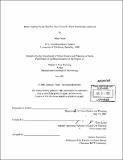| dc.contributor.advisor | Terry Szold. | en_US |
| dc.contributor.author | Varat, Adam (Adam Simon), 1976- | en_US |
| dc.contributor.other | Massachusetts Institute of Technology. Dept. of Urban Studies and Planning. | en_US |
| dc.date.accessioned | 2011-08-01T14:34:01Z | |
| dc.date.available | 2011-08-01T14:34:01Z | |
| dc.date.copyright | 2001 | en_US |
| dc.date.issued | 2001 | en_US |
| dc.identifier.uri | http://hdl.handle.net/1721.1/65059 | |
| dc.description | Thesis (M.C.P.)--Massachusetts Institute of Technology, Dept. of Urban Studies and Planning, 2001. | en_US |
| dc.description | Includes bibliographical references (leaves [114]-[117]). | en_US |
| dc.description.abstract | The history of shopping centers in the United States is closely associated with decentralizing urban trends and increased auto dependence, both of which have severe environmental effects. Retail formats have shifted over the years from downtown shopping to indoor shopping centers, and more recently to big box superstores. As retail formats and markets continue to evolve, many older, less modem stores have suffered. Most recently, this trend has affected big boxes, creating an opportunity to reuse and re-image many of these sites. Vacant shopping centers represent an expanding phenomenon that has been little studied. I survey examples of vacant superstores in the Boston region, and characterize their physical and neighborhood characteristics, as well as procedural barriers and opportunities toward reusing these sites in a way that promotes land-efficient, non-auto-dependent development. I found two primary types of site: urban and suburban. In both types, site plan characteristics are similar. They have low density site plans, and are serviced almost entirely by the automobile. There are few concessions to pedestrian or transit amenity, and in both cases, sites are disconnected from surrounding parcels. Both also face similar procedural redevelopment difficulties, especially regarding ownership and tenant issues, sprawl-oriented zoning regimes, and known but uncertain levels of environmental contamination. However, characteristics of the surrounding areas differ greatly between the two types. "Urban" sites are located in compact, connected, older suburban areas with connected street grids. The shopping center parcels represent a coarse-grain anomaly in a fine-grain area. "Suburban" types are located in urban fringes, in areas that are primarily single-use, auto-oriented, and poorly connected. Planning for both types of site should account for urban design and pedestrian connectivity deficiencies by encouraging connections among different sites and to circulation systems, and to take advantage of other underutilized parcels nearby. To this end, municipalities should plan for an entire area surrounding the shopping center sites, using the tools of design guidelines, site plan review, and flexible zoning regimes. Additionally, municipalities should engage and coordinate private and community sectors to promote cohesion among many sites. Suburban sites should emphasize site planning for connectivity and directing new superstores into existing space. Urban sites should capitalize on existing neighborhood infrastructure to reintegrate the sites into surrounding neighborhoods, and to direct investment and development away from auto-dependent greenfield sites to connected, accessible locations within the metropolitan region. | en_US |
| dc.description.statementofresponsibility | by Adam Varat. | en_US |
| dc.format.extent | 113, [4] leaves | en_US |
| dc.language.iso | eng | en_US |
| dc.publisher | Massachusetts Institute of Technology | en_US |
| dc.rights | M.I.T. theses are protected by
copyright. They may be viewed from this source for any purpose, but
reproduction or distribution in any format is prohibited without written
permission. See provided URL for inquiries about permission. | en_US |
| dc.rights.uri | http://dspace.mit.edu/handle/1721.1/7582 | en_US |
| dc.subject | Urban Studies and Planning. | en_US |
| dc.title | Redeveloping big box sites toward a more sustainable land use | en_US |
| dc.type | Thesis | en_US |
| dc.description.degree | M.C.P. | en_US |
| dc.contributor.department | Massachusetts Institute of Technology. Department of Urban Studies and Planning | |
| dc.identifier.oclc | 49745634 | en_US |

